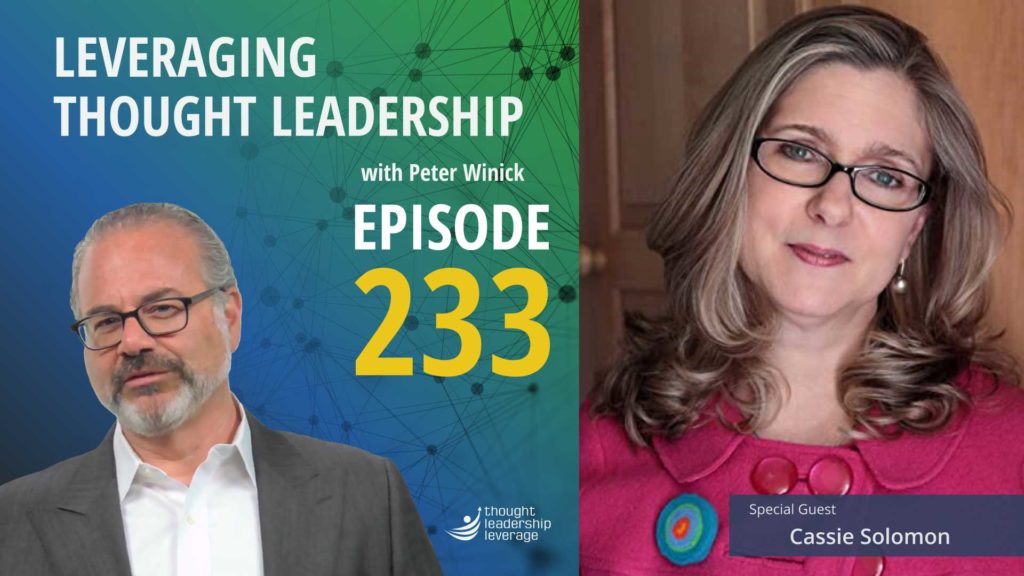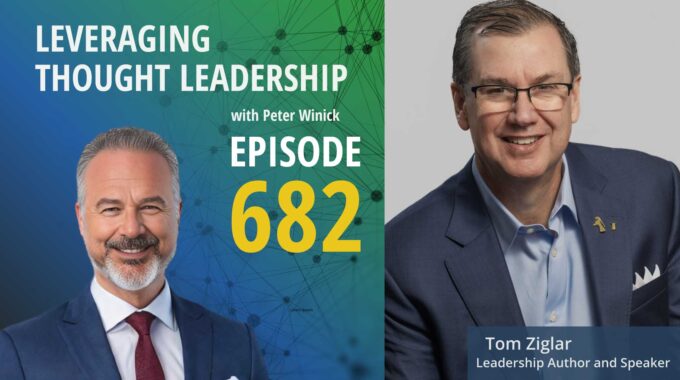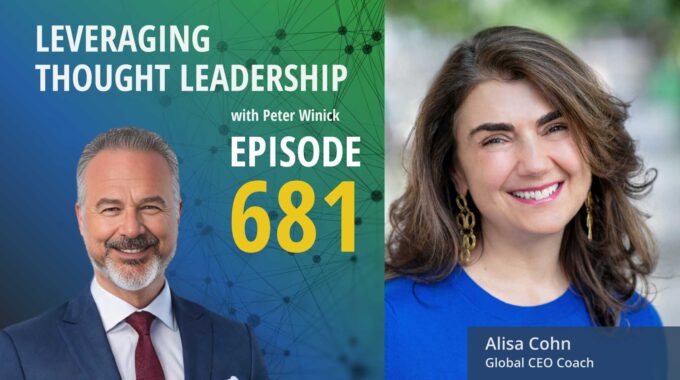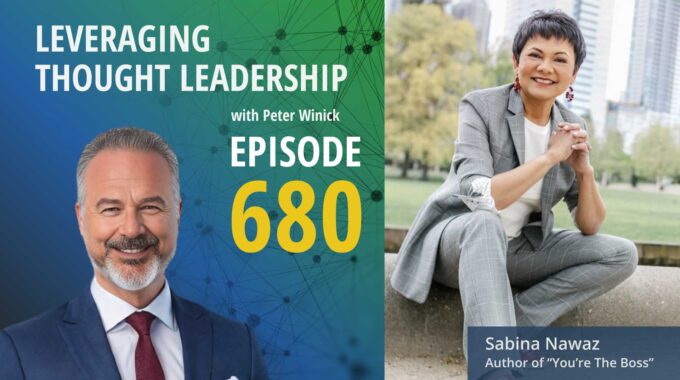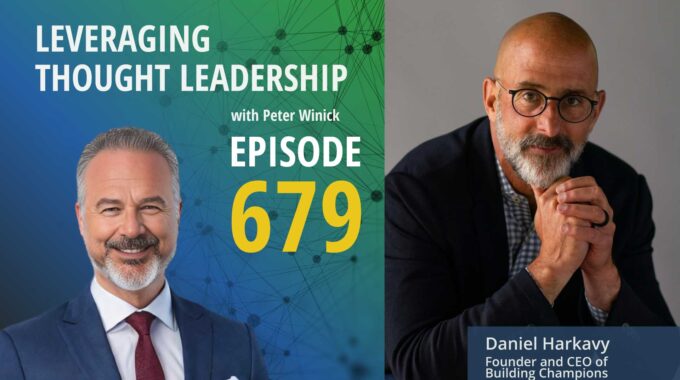How AI, Programs, and Trust Turn Ideas into a Life-Changing Business This episode explores how…
Thought Leadership Marketing and Effective Change | Cassie Solomon
What Is the Importance of Thought Leadership Marketing in a Changing World?
An interview with Cassie Solomon about thought leadership marketing, content marketing, and business strategy.
We interviewed Cassie Solomon, CEO of New Group Consulting and a thought leader with a focus on organizational design, workforce transformation and the introduction of new technology. As a consultant, she helps leaders accelerate specific change initiatives. Cassie works with thought leadership marketing to shape a better future for her clients; to enhance accountability and improve decision making practices, and master the skills they will need to move forward.
Cassie shares her experience as a co-author with Gregory Shea and how his academic approach blends perfectly with her case study method. She also discusses revising the book to include more relevant cases from her own experiences. Also, she talks about her next book and the pivot to helping clients navigate an uncertain future and how her expertise in change management fits perfectly into her emerging role as a futurist.
Three Key Takeaways from the Interview:
- What will thought leadership marketing look like in the future?
- How to roll your thought leadership marketing into a plan for success that moves beyond current events, and into globalization
- What a thought leader needs to know about thought leadership marketing in order to change their expectations of strategy, client interface, and more.
Do you want to push your thought leadership marketing further, establish relationships within your target community, and generate leads for future sales? Reach out to Thought Leadership Leverage and see what we can do for you!
Transcript
Peter Welcome. Welcome, welcome. This is Peter Winick, the founder and CEO of Thought Leadership Leverage. And you’re joining us on the podcast today, which is leveraging thought leadership. Today, my guest is Cassie Solomon. As you come to The New Group in 1997 to create a fund dedicated to helping leaders design and implement successful change. Her book, Leading Successful Change Eight Keys to Making Change Work, coauthored with Greg Shay, was published in February 13 by Wharton Digital Press. Her assignments focus on work design, workforce transformation and the introduction of new technology. She’s an internationally recognized expert on RACI, which a project management tool. She’s currently working on her new book, which may be out shortly if it’s not called The Augmented Provider. And she is also, or was in a previous life a consultant at CFAR, which is a Philly based consulting firm that was spun out of the one school business in 1987. Anyway, here we are. I can go on and on with your intro, but that would eat into valuable chat time here. So welcome aboard. How are you?
Cassie Solomon Thank you. Very nice to be on the podcast. Peter, and great to see you again.
Peter Thank you. Thank you. So let’s start with you. Sort of how the heck did you get here? Right. Not nobody or very few people wake up one day and say, I’m going to be an author or consultant and advisor and run a consulting firm as well as be involved in executive and all the other things that you’ve done. So how has that happened and how do some of the parts that look like they might be connected connect?
Cassie Solomon So I was with a consulting firm initially doing a lot of work and organizational change and went out on my own. It’s about 13 years ago now. And that is, you know, as most of those of us who are on our own, we’ll tell you, is it is pretty daunting to do it. But I started using Greg’s change model in the assignments that I was getting.
Peter And that’s Greg Shea?
Cassie Solomon You’re correct. Yeah. And I was really bowled over by how successful it was. And, you know, the research that we later did, you know, something like between 50 and 75 percent of change initiatives fail. So when I was really impressed with how this approach to change is working. Greg and I’ve actually known each other since we were both at Yale. So I said, you know, Greg, this thing is incredible and you’ve got to write the book. And he said, well, why don’t we just write the book together? So that was 2013. And I think from that way we just see I want to just pack a point there. Anytime somebody says you should write the book and they counter with, yeah, no, you should write the book.
Peter And they become co-authors, you know, to write. Oh, my. Careful what you wish for.
Cassie Solomon Absolutely. This is now a marriage. You know, it’s always had ups and downs. And I believe me, he would say the same. So I think where we sort of found our spot in terms of our relationship as writers is that I tend to do the case writing. You know, I’m a practitioner. I’m sure they’re kind of sometimes I call myself I’m like the mechanic that slides underneath the car with a friend. You got to change something, you know, send me in. And so I tend to be the one. Focuses more on writing in the cases, and so the revised book, which was just done over the summer and published in the library, was really a labor of love for me because we took out cases that were based on secondary material in the first book and put in cases from my clients in the second book.
Peter So I went, I want to question something you said there. So you said, you know, you’re the mechanic. So does that mean Greg’s the more academic in terms of his style?
Cassie Solomon He does his share of consulting. But yes, he does a lot more teaching than I do. And when we look at each together at Wharton, he’s sort of hands, you know, the class over to me and says Cassie will now teach the model and she’ll bring you cases and cool.
Peter I want to touch on that, because I think that that dance between the two doesn’t happen often enough. I called her the Reese’s peanut butter. You put your chocolate on my peanut butter, whatever. Normally there’s this silly debate or conflict between the academic that is, you know, I’ve studied this, I model this. And here’s all the quantum. But it ended on its regression study, whatever. And then the practitioner goes, yes. But when you’re in the real world and you know, you don’t have the wrench, you’ve got to use the pliers. You know, you don’t always get by and it doesn’t always work like that. And instead of arguing, actually, I think it’s more powerful when the two of you can dance together and say, yes, here’s the models and here’s why the models are valid. And by the way, models are just one way of looking at the world. And there are no models of perfect. And here’s the reality. And when you learn that way, because usually in practice, in the real world, it’s a little bit about you have to respect the model and B, be fluid or agile enough to go. And all this has been a perfect scenario for us.
Cassie Solomon I mean, he’s. He’s classically trained and I am, too. But now I’m sort of using jazz. You know, when I work, that would be the metaphor I would use.
Peter Got it. Got it. So was the revised version of the book the same publisher was at Wharton Press as well?
Cassie Solomon Yes, it’s a Wharton School press. They’ve changed their name in the meantime. And it’s you know, they’re just a fantastic, you know, wing partner to have as a publisher. There was the whole. I think it’s a million people in the Wharton community. So that’s where we can kind of send the message. They feature it in their knowledge for Wharton and the blog that goes out a couple of times a week. Oh, it’s a great relationship with them.
Peter And you’ve got the new book. When is that due?
Cassie Solomon That is kind of my practices actually morphing as more of my clients for whom I do organizational change have sort of asked me to look into the future with them and say, you know, there’s a hell of a lot of change on the horizon. Cassie, you know, let’s try to figure that out together. And I actually had to go and become certified as a futurist after a couple of years of doing this.
Peter And there’s a body that certifies people and being futurists here is it’s a great body.
Cassie Solomon It’s the Institute for the Future in Palo Alto. And it was conducted 60 years ago by the Rand Corporation. And they’re just they’re terrific anyway.
Peter Does their softball team play against the destroying society around them?
Cassie Solomon I’m not in Palo Alto. I just kind of remote in.
Peter No, I know.
Cassie Solomon You know, this this next book is hoping to capture the work that I’ve been doing the last couple of years, which is sort of helping organizations look into the future both with their strategy and with their workforce development.
Peter Got it. Got it. So tell us a little bit about your the blend of your work. So in a typical month and we’re living in times are not quite typical. But let’s just go back to the quaint old days of, you know, a couple of weeks ago. What’s the mix in terms of how you spend your time researching, writing, serving clients? What was it? Was it looked like?
Cassie Solomon So it’s interesting because I think there are two flavors that I’ve experienced with this. And the first one is really the easiest, because if I’m working with a client, I’m, you know, doing things either with the model or with this futures work, that can then become a story that both of us want to tell. So, for example,.
Peter Both meaning you and the client, me and the client. That’s interesting.
Cassie Solomon One of the cases, for example, in the book, my client work with Twitter, and that’s been really fascinating. And so going to my client, Meg Hailie, and saying, you know, this is really important work, let’s write this together and I’ll put it in the next version of the book, you’ll get into a lot of permissions issues and. Yeah, yeah, yeah. Is very visible like Twitter. And in the new life, like Twitter, there was there was a period there where I thought we were not going to get the approvals that we needed, but that a couple of cases in the book that are based on client work. So that’s a fantastic synergistic relationship. You’re doing the work and the work is going well and then you’re writing about the work that you just did. And I think then that’s interesting for people because it’s not theoretical. It’s grounded in real stories. And that’s sort of the first flavor. The second one, and I think this is one of the things I’d like to do next, is finding something through secondary research, something. That’s it. And then writing about it. And the example that ended up in the book is a company called ID-XDR and one in science, a physician named Mark Schneider. And I wrote a blog for Warton about this company’s technology, which is really groundbreaking. Then I got to know the company’s founder and CEO and interviewed him for the case. If we expanded, it became a case in the book. And now he’s helping me with something else that I’m doing, pulling together an alliance of A.I. researchers. So I that wasn’t even a relationship. That was just me reading something, you know, insurance, writing about it and then creating the relationship.
Peter Interesting. And then what is. So using that as an example. Weird. What’s the monetization component to that? So because you develop this this work, this content. And now what how does that how does it serve the business side? Because you’re sort of a for profit researcher. Right. Embedded in your own consulting company.
Cassie Solomon Absolutely. I’m not sure that the relationship is always direct. I think it can be direct. You know, in this case, the things that I was learning as I was writing about ideas, ID-XDR. And I ended up pivoting and using with a national group of banking regulators. So there is a wild switch, right? They were the same learnings. I just had to put them down in a different setting with us with a different client.
Peter Got it. Got it. What are the other sort of lines of work that you do? You give me a sense of the you know what the practice looks like types of problems you solve to solve them for sure.
Cassie Solomon I do. I’d say they’re probably three practice areas. Peter, the first one is Zach. I think of as executive change coaching and executive coaching with a traditional H R lens. I don’t want to give you a personality assessment and then make you listen. I want to come on board when you’re facing a really significant change, opportunity or threat and you really need somebody riding shotgun that knows what they’re doing.
Peter So that changes business shape, not some sort of a personal life event change. So the changes business to an acquisition product launch change in the markets a lot. Right.
Cassie Solomon And I tend to find myself in really wickedly complex stakeholder situations. So, you know, get in there. And university project that has trying to pull together five deans. You know, that’s one of the projects that my client is working on. So executive change coaching is the first one really supporting senior teams in imagining and designing change. And this is it really comes out of that orientation in the work that you actively design a change, you know, kind of pass into it and hope for the best. And so what you do upfront is really critical to the success or failure of that change initiative. And so, you know, different kinds of problems fall under that category. Sometimes it’s, you know, oh, is that a bad employee engagement score? And you don’t think it’s good enough? So that’s a change we want to make. You know, it might be we want to introduce a whole new level of technology and digitization, and we’re not ready for that yet. Come help us think that through. And really, the third area is more just straight up strategic planning. It’s no surprise because that is not my background. And yet I think having the organizational change that really actually helps you create more powerful strategic planning processes that kind of sweep people in. And when you’re done, if you do it right, you know, you don’t just have a plan that sits on the shelf. You have a plan that people have really lived themselves in.
Peter So I want I want to touch on that, because, I mean, there’s strategic planning as a discipline. You’ve got folks that’s there. That’s what they do. Right. But you’re doing that. But if you do it and you’re doing it well and you’re attributing the success there to your org change site. Right. Because you know what is changed without a change. Right. And that’s interesting. Does that when you’re doing those engagements, do you sort of bury the lead or is it. No, this is I am I am a domain expertise in or change that will help you develop the strategy because it seems a little counterintuitive. If I if you were in a bake off against two others and we’ve got, you know, strategy practitioner, strategy, practitioner and wait, like she doesn’t sort of fit the mold. How was that a good thing and how is it a maybe a challenge?
Cassie Solomon So I definitely don’t bury the lead. And so far, I think it’s a good thing. I don’t think there are any strategies around right now that don’t involve a tremendous amount of organizational change. You can’t separate them at the end of the day, even if, you know, went off into a closet and made your strategy and then came out and announced it, you’re gonna take your organization through significant change. And how you create the plan really sets you up for success or failure. So, for example, I’ve got to put a proposal in next week and they have very clear ideas. They want like 40 interviews of these stakeholders and they want 30 interviews of these stakeholders. And I said, that’s not that’s not a good idea. People are not going to be engaged in no way with whose I went to.
Peter So the day is the client says this is the way by which you will -. And so you’re saying, well, you’re only doing that to try to get to this outcome. But I have a better tool or what better way to get back?
Cassie Solomon I think you can have a proposal. But that’s not the design you’re going to get. Yes. Yes. All right. Now, if that alarms you, because I’m looking at it through my lens and people are not going to be engaged in the end product if they just, you know, get interviewed for 30 minutes and then seven months later there’s a plan or even three months later there’s a plan. And so they have they have a very complex stakeholder situation and they need to get people actively engaged in talking about the strategic priorities anyway. So there’s a there’s a tremendous design element in all of this. Strategic planning. Yeah. No interest for work change work.
Peter Yeah. Yeah. So I want to move for a couple of minutes as we start to wrap in a few minutes to just sort of the business side of the business. Right. So where you can do this for while you’ve got a great reputation. You know, this isn’t your first rodeo, as they say. I don’t know who that is, but someone to the point where does deal flow come from his referrals, you know, is it. You know, the marketing side, the sales side, the getting the content out there. How does magic happen? And you wind up having, you know, the right type of engagements and the right frequency at the right price point that you like?
Cassie Solomon Well, I think, you know, I’m definitely figuring all of this out. But having survived and thrived for 13 years, it’s been a journey I mostly figured out. I think word of mouth is certainly a large part of it. I think teaching at executive education is also very helpful. That’s how I met Twitter, for example.
Peter That’s like a free sample, right. So if you’re meaning if Twitter is paying whatever Warton to bring in a cohort of folks there, and even if you’re not leading it, but you’ve got a three hour slice of whatever. That’s an eye opener for them.
Cassie Solomon Yeah, that’s a fantastic mechanism. Not available to everyone. But, you know, water. Sure. I want someone to teach organizational change. And so you’re kind of starting out with both the expertise and the credibility of something like Wharton behind you. The other, I think really is the writing. And I’ve a Web site that’s devoted to RACI, as you mentioned. And yes, because I’m really interested in something. We’ve talked about horizontal leadership, how people work across departments, down silos. It’s getting even more interesting because organizations are partnering and networks are forming. You probably have heard a lot about platform organization at that set of skills is something that I write about through that RACI Web site and all kinds of interesting clients have found me. Their problem is we can’t get decisions made fast enough. People infighting across silos.
Peter Well, we’re matrix. We’re confused where, who or who owns that or, you know, whatever.
Cassie Solomon The tagline on that website is, clarity starts here. And so when they come when they come to me that way, it’s just it’s been really refreshing because a lot of different kinds of companies have found me through that pipeline. Global manufacturer a couple of months ago when before we had these problems, they had suppliers in China, trade wars and distribution centers in Britain and Brexit. So before long, you know, you’re talking strategy. Even if you come in the door talking about how can I get your new product development process cleaned up.
Peter Right. Not quite so simple. Exactly. Great. Well, this has been fantastic. Appreciate your time. And I appreciate you sharing your story and your journey with us. And thank you very much.
Cassie Solomon Thanks, Peter. Great to see you. Thanks. Bye.
